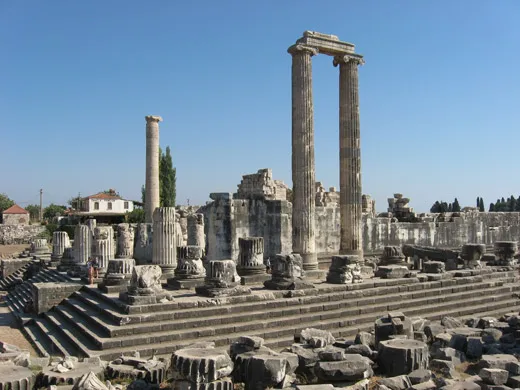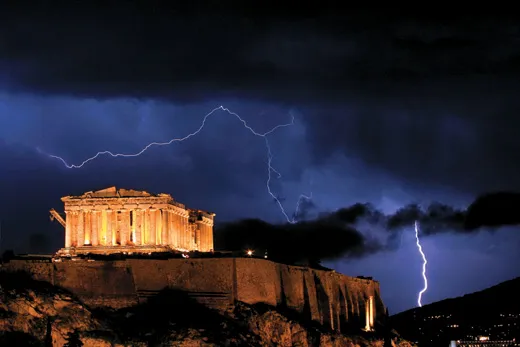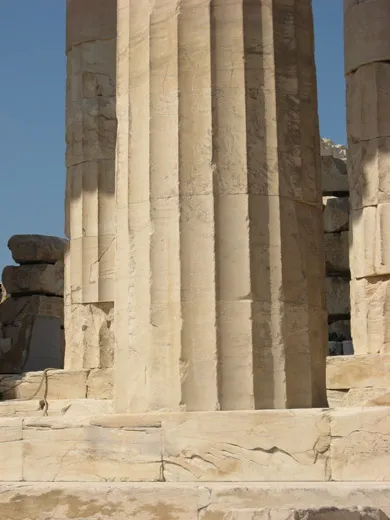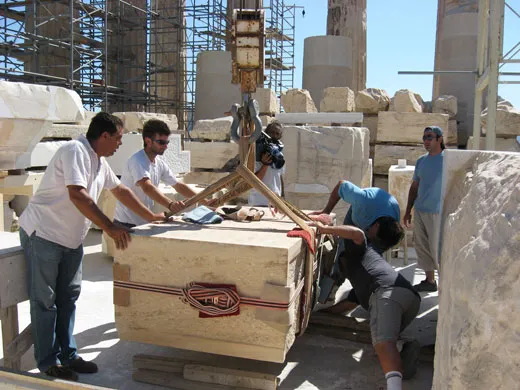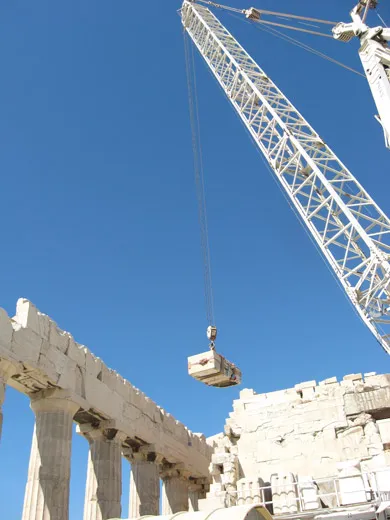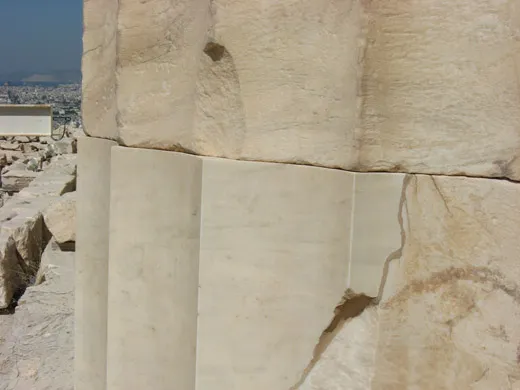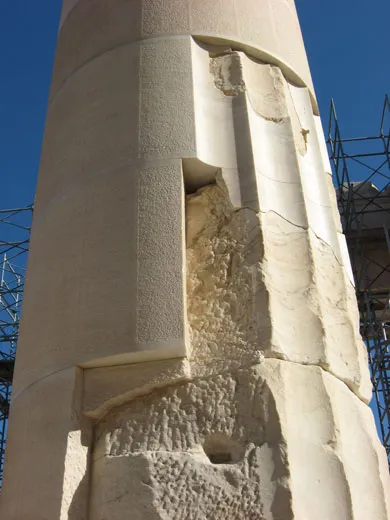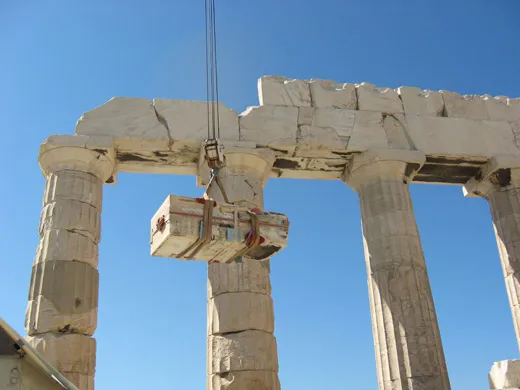Unlocking Mysteries of the Parthenon
Restoration of the 2,500-year-old temple is yielding new insights into the engineering feats of the golden age’s master builders
Editor’s Note: This article was adapted from its original form and updated to include new information for Smithsonian’s Mysteries of the Ancient World bookazine published in Fall 2009.
During the past 2,500 years, the Parthenon—the apotheosis of ancient Greek architecture—has been rocked by earthquakes, set on fire, shattered by exploding gunpowder, looted for its stunning sculptures and defaced by misguided preservation efforts. Amazingly, the ancient Athenians built the Parthenon in just eight or nine years. Repairing it is taking a bit longer.
A restoration project funded by the Greek government and the European Union is now entering its 34th year, as archaeologists, architects, civil engineers and craftsmen strive not simply to imitate the workmanship ofthe ancient Greeks but to recreate it. They have had to become forensic architects, reconstructing long-lost techniques to answer questions that archaeologists and classical scholars have debated for centuries. How did the Athenians construct their mighty temple, an icon of Western civilization, in less than a decade—apparently without an overall building plan? How did they manage to incorporate subtle visual elements into theParthenon’s layout and achieve such faultless proportions and balance? And how were the Parthenon’s builders able to work at a level of precision (in some cases accurate to within a fraction of a millimeter) without the benefit of modern tools? “We’re not as good as they were,” Lena Lambrinou, an architect on the restoration project, observes with a sigh.
If the Parthenon represents “the supreme effort of genius in pursuit of beauty,” as the 19th-century French engineer and architectural historian Auguste Choisy declared, lately it has been looking more like a construction site. Ancient masonry hides behind thickets of scaffolding, planks and steel poles. Miniature rail tracks connect sheds that house lathes, marble cutters and other power equipment. In the Parthenon’s innermost sanctuary, once the home of a massive ivory-and-gold statue of Athena, a gigantic collapsible crane turns on a concrete platform.
Though heavy equipment dominated the hilltop, I also found restorers working with the delicacy of diamond cutters. In one shed, I watched a mason toiling on a fresh block of marble. He was one of some 70 craftsmen recruited for the project from Greece’s sole remaining traditional marble school, located on the island of Tinos. His technique was exacting. To make the new block exactly match an old, broken one, the mason used a simple pointing device—the three-dimensional equivalent of a pantograph, which is a drafting instrument for precisely copying a sketch or blueprint—to mark and transfer every bump and hollow from the ancient stone to its counterpart surface on the fresh block. On some of the largest Parthenon blocks, which exceed ten tons, the masons use a mechanized version of the pointing device, but repairing a single block can still take more than three months. The ancient workers were no less painstaking; in many cases, the joints between the blocks are all but invisible, even under a magnifying glass.
The Parthenon was part of an ambitious building campaign on the Acropolis that began around 450 b.c. A generation before, the Athenians, as part of an alliance of Greek city-states, had led heroic victories against Persian invaders. This alliance would evolve into a de facto empire under Athenian rule, and some 150 to 200 cities across the Aegean began paying Athens huge sums of what amounted to protection money. Basking in glory, the Athenians planned their new temple complex on a lavish, unprecedented scale—with the Parthenon as the centerpiece. Surviving fragments of the financial accounts, which were inscribed in stone for public scrutiny, have prompted estimates of the construction budget that range from around 340 to 800 silver talents—a considerable sum in an age when a single talent could pay a month’s wages for 170 oarsmen on a Greek warship. The Parthenon’s base was 23,028 square feet (about half the size of a football field) and its 46 outer columns were some 34 feet high. A 525-foot frieze wrapped around the top of the exterior wall of the building’s inner chamber. Several scholars have argued that the frieze shows a procession related to the quadrennial Great Panathenaia, or the festival “of all the Athenians.” By incorporating this scene of civic celebration, the scholars suggest, the Parthenon served not merely as an imperial propaganda statement but also as an expression of Athens’ burgeoning democracy—the will of the citizens who had voted to fund this exceptional monument.
When the current restoration effort began in 1975, backed by $23 million from the Greek government, the project’s directors believed they could finish in ten years. But unforeseen problems arose as soon as workers started disassembling the temples. For example, the ancient Greek builders had secured the marble blocks together with iron clamps fitted in carefully carved grooves. They then poured molten lead over the joints to cushion them from seismic shocks and protect the clamps from corrosion. But when a Greek architect, Nikolas Balanos, launched an enthusiastic campaign of restorations in 1898, he installed crude iron clamps, indiscriminately fastening one block to another and neglecting to add the lead coating. Rain soon began to play havoc with the new clamps, swelling the iron and cracking the marble. Less than a century later, it wasclear that parts of the Parthenon were in imminent danger of collapse.
Until September 2005, the restoration’s coordinator was Manolis Korres, associate professor of architecture at the National Technical University of Athens and a leading Parthenon scholar who had spent decades poringover every detail of the temple’s construction. In a set of vivid drawings, he depicted how the ancient builders extracted some 100,000 tons of marble from a quarry 11 miles northeast of central Athens, roughly shaped the blocks, then transported them on wagons and finally hauled them up the steep slopes of the Acropolis. Yet all that grueling labor, Korres contends, was dwarfed by the time and energy lavished on fine-tuning the temple’s finished appearance. Carving the long vertical grooves, or flutes, that run down each of the Parthenon’s main columns was probably as costly as all the quarrying, hauling and assembly combined.
Today’s restorers have been replacing damaged column segments with fresh marble. To speed up the job, engineers built a flute-carving machine. The device, however, is not precise enough for the final detailing, which must be done by hand. This smoothing of the flutes calls for an expert eye and a sensitive touch. To get the elliptical profile of the flute just right, a mason looks at the shadow cast inside the groove, thenchips and rubs the stone until the outline of the shadow is a perfectly even and regular curve.
The ancients spent a lot of time on another finishing touch. After the Parthenon’s exposed marble surfaces had been smoothed and polished, they added a final, subtle texture—a stippling pattern—that Korres says dulled the shine on the marble and masked its flaws. With hundreds of thousands of chisel blows, they executed this pattern in precisely ordered rows covering the base, floors, columns and most other surfaces. “This was surely one of the most demanding tasks,” Korres says. “It may have taken as much as a quarter of the total construction time expended on the monument.”
With such fanatical attention to detail, how could the Parthenon’s architects have finished the job in a mere eight or nine years, ending somewhere between 438 and 437 b.c.? (The dates come from the inscribed financial accounts.) One key factor may have been naval technology. Since the Athenians were the greatest naval power in the Aegean, they likely had unrivaled mastery of ropes, pulleys and wooden cranes. Such equipment would have facilitated the hauling and lifting of the marble blocks.
Another, counterintuitive possibility is that ancient hand tools were superior to their modern counterparts. After analyzing marks left on the marble surfaces, Korres is convinced that centuries of metallurgical experimentation enabled the ancient Athenians to create chisels and axes that were sharper and more durable than those available today. (The idea is not unprecedented. Modern metallurgists have only recently figuredout the secrets of the traditional samurai sword, which Japanese swordsmiths endowed with unrivaled sharpness and strength by regulating the amount of carbon in the steel and the temperature during forging and cooling.) Korres concludes that the ancient masons, with their superior tools, could carve marble at more than double the rate of today’s craftsmen. And the Parthenon’s original laborers had the benefit of experience, drawing on a century and a half of temple-building know-how.
Moreover, the restoration team has confronted problems that their ancient Greek counterparts could never have contemplated. During the Great Turkish War in the late 17th century—when the Ottoman Empire was battling several European countries—Greece was an occupied nation. The Turks turned the Parthenon into an ammunition dump. During a Venetian attack on Athens in 1687, a cannonball set off the Turkish munitions, blowing apartthe long walls of the Parthenon’s inner chamber. More than 700 blocks from those walls—eroded over time—now lay strewn around the Acropolis. For five years, beginning in 1997, Cathy Paraschi, a Greek-American architect on the restoration project, struggled to fit the pieces together, hunting for clues such as the shape and depth of the cuttings in the blocks that once held the ancient clamps. Eventually, she abandoned her computer database, which proved inadequate for capturing the full complexity of the puzzle. “Some days were exhilarating,” she told me, “when we finally got one piece to fit another. Other days I felt like jumping off the Acropolis.” In the end, she and her co-workers managed to identify the original positions of some 500 of the blocks. Looming over each restoration challenge is the delicate question of how far to go. Every time the workers dismantle one of Balanos’ crude fixes, it is a reminder of how destructive an overzealous restorer can be. Asthe director of the Acropolis Restoration Project, Maria Ioannidou, explains, “we’ve adopted an approach of trying to restore the maximum amount of ancient masonry while applying the minimum amount of new material.”That means using clamps and rods made of titanium—which won’t corrode and crack the marble—and soluble white cement, so that repairs can be easily undone should future generations of restorers discover a better way.
There have been some bravura feats of engineering. The 1687 explosion knocked one of the massive columns out of position and badly damaged its bottom segment. A serious earthquake in 1981 damaged it further, and theentire column appeared at risk of toppling. The obvious procedure was to dismantle the column, one segment after another, and replace the crumbling section. Korres, hoping, he said, to avoid “even the smallest departure from the column’s perfection and authenticity of construction,” designed a metal collar that exerts precisely controlled forces to grasp a column securely without harming the stone. In the early 1990s, after the careful removal of the overhead blocks and lintels, the collar was suspended by turnbuckles (adjustable connectors) inside a mounted, rectangular steel frame. By tightening the turnbuckles, the team raisedthe 55-ton column less than an inch. They then removed the bottom segment—which they repaired with fresh marble to an accuracy of one-twentieth of a millimeter—and slid it back into position. Finally, they lowered the rest of the column into place on top of the repaired segment. “It was a bold decision to do it this way,” Korres says. “But we were young and daring then.”
Perhaps none of the Parthenon’s mysteries stirs more debate than the gentle curves and inclinations engineered throughout much of its design. There is hardly a straight line to be found in the temple. Experts argue over whether these refinements were added to counter optical illusions. The eye can be tricked, for instance, into seeing an unsightly sag in flat floors built under a perched roof like the Parthenon’s. Possibly to correct this effect, the Athenians laid out the Parthenon’s base so that the 228-by-101-foot floor bulges slightly toward the middle, curving gradually upward between 4 and 4 1/2 inches on its left and right sides, and 2 1/2 inches on its front and back. One theory holds that this slight upward bulge was built simply to drain rainwater away from the temple’s interior. But that fails to explain why the same curvingprofile is repeated not only in the floor but in the entablature above the columns and in the (invisible) buried foundations. This graceful curve was clearly fundamental to the overall appearance and planning of the Parthenon.
And then there are the columns, which the Athenians built so that they bulged slightly outward at the center. This swelling was termed entasis, or tension, by Greek writers, perhaps because it makes the columns seemas if they are clenching, like a human muscle, under the weight of their load. Again, some scholars have long speculated that this design might compensate for another trick of the eye, since a row of tall, perfectlystraight-sided pillars can appear thinner at the middle than at the ends.
No matter the motivation for these refinements, many early scholars assumed that crafting such visual elements imposed tremendous extra demands on the Parthenon’s architects and masons. (One wrote of the “terrifyingcomplications” involved.) No architectural manuals survive from the Classical Greek era, but today’s experts suspect the temple builders could add curves and inclined angles with a few relatively simple surveying tricks. “If you’re building without mortar, every block...must be trimmed by hand,” notes Jim Coulton, professor emeritus of classical archaeology at Oxford University. “Although tilts and curvatures would require careful supervision by the architect, they don’t add a lot to the workload.”
Still, how could each column segment be measured so that all would fit together in a single, smoothly curving profile? The likely answer was found not in Athens but nearly 200 miles away in southwestern Turkey. In the town of Didyma rises one of the most impressive relics of the ancient world, the Temple of Apollo. Three of its 120 colossal columns still stand, each nearly twice the height of the Parthenon’s. The wealthy trading city of Miletus commissioned the temple in the age of Alexander the Great, around 150 years after completion of the Parthenon. The gigantic ruins testify to a project of grandiose ambition: it was never finished despite 600 years of construction efforts. But thanks to its unfinished state, crucial evidence was preserved on temple walls that had not yet undergone their final polishing.
A few years after the Parthenon restoration began, University of Pennsylvania scholar Lothar Haselberger was on a field trip exploring the Temple of Apollo’s innermost sanctuary. He noticed what seemed to be patterns of faint scratches on the marble walls. In the blinding morning sunlight the scratches are all but invisible, as I discovered to my initial frustration when I searched for them. After the sun had swung around and began grazing the surface, however, a delicate web of finely engraved lines started to emerge. Haselberger recalls, “All of a sudden I spotted a series of circles that corresponded precisely to the shape of a column base, the very one at the front of the temple.” He realized he had discovered the ancient equivalent of an architect’s blueprint.
Then, just above the outline of the column base, Haselberger noticed a pattern of horizontal lines with a sweeping curve inscribed along one side. Could this be related to entasis, also evident in the towering Didyma columns? After carefully plotting the pattern, the answer became clear: it was a profile view of a column with the vertical dimension—the height of the column—reduced by a factor of 16. This scale drawing must have been a key reference for the masons as they carved out one column segment after another. By measuring along the horizontal lines to the edge of the curve, they would know exactly how wide each segment would have to be to create the smooth, bulging profile. Manolis Korres believes that the ancient Athenians probably relied on a carved scale drawing similar to the one at Didyma in building the columns of the Parthenon.
Haselberger also traced a labyrinth of faint scratches covering most of the temple’s unfinished surfaces. The lines proved to be reference drawings for everything from the very slight inward lean of the walls to details of the lintel structure supported by the columns. There were even floor plans, drafted conveniently right on the floor. As the temple’s stepped platform rose, each floor plan was copied from one layer to thenext. On the topmost floor, the builders marked out the positions of columns, walls and doorways.
The discoveries at Didyma suggest that the temple builders operated on a “plan-as-you-go” basis. “Clearly, a lot of advance planning went into a building like the Parthenon,” Coulton says. “But it wasn’t planning inthe sense that we’d recognize today. There’s no evidence they relied on a single set of plans and elevations drawn to scale as a modern architect would.”
Still, the Parthenon remains something of a miracle. The builders were steered by tradition, yet free to experiment. They worked to extreme precision, yet the final result was anything but rigid. A commanding building, with supple and fluid lines, emerged from a blend of improvised solutions.
But the miracle was short-lived. Only seven years after the construction of the Parthenon was completed, war broke out with Sparta. Within a generation, Athens suffered a humiliating defeat and a devastating plague.The story of the Parthenon resembles an ancient Greek tragedy, in which an exceptional figure suffers a devastating reversal of fortune. And from Korres’ perspective, that calamity is all the more reason to restore the greatest remnant of Athens’ golden age. “We wanted to preserve the beauty of what has survived these past 2,500 years,” he says. “A reminder of man’s power to create, as well as to destroy.”
